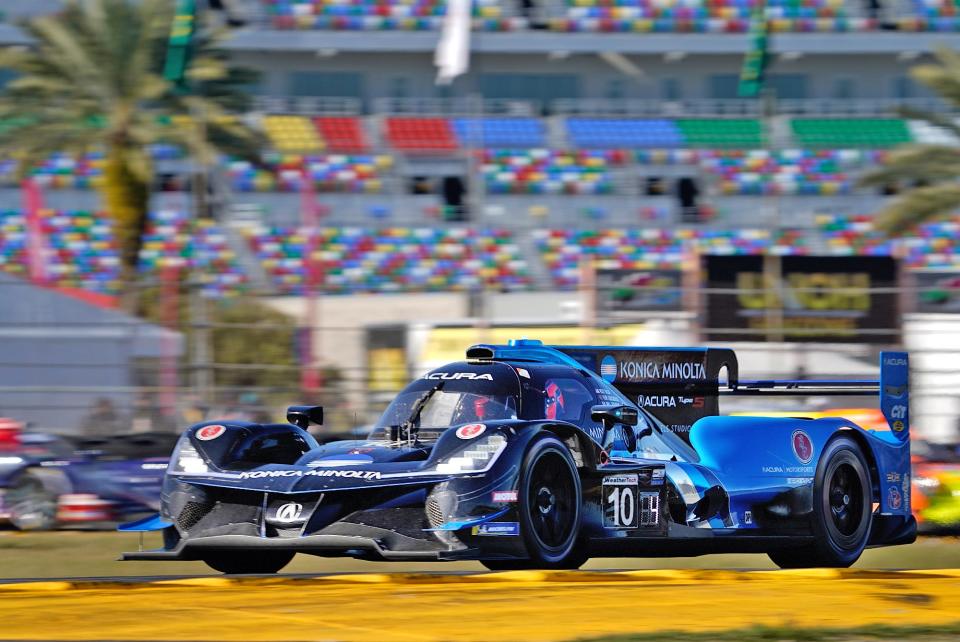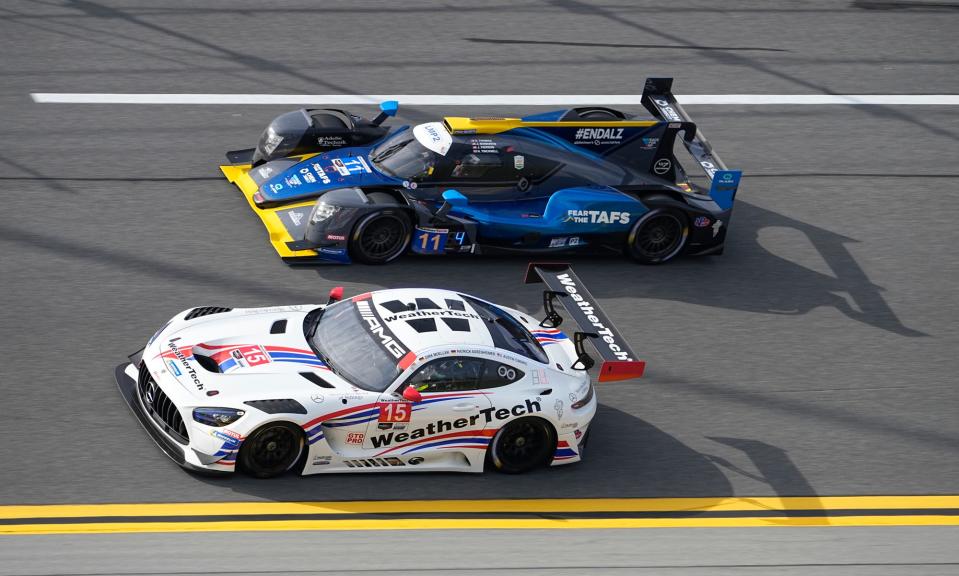Ever wonder what's under the hood of the different Rolex 24 cars at Daytona? Let's compare
There are 61 cars entered in this weekend's Rolex 24 — the biggest field in nearly a decade — including seven in the Prototype class, 10 in LMP2, nine in the LMP3 class, 13 in GTD Pro and 22 in GTD.
You'll notice a name missing from that list: GT Le Mans. Yep, that class is now gone while the GT class has combined into two categories. That class is loaded this season and will take up over half of this weekend's field.
The Wayne Taylor No. 10 Acura will lead all 61 cars to green Saturday (1:40 p.m.) after winning last weekend's qualifying race in thrilling fashion, holding off a late charge by the No. 5 Cadillac DPi machine, driven by Richard Westbrook.
Through the Gears: How will the Next Gen racing look at Daytona? Dale Jr. weighs in
Traffic jam: Roar Before the Rolex 24 starts the clock on 2022 motorsports season
Last year's classes: How do the 5 types of car classes stack up at the Rolex 24 At Daytona? Let's compare them.
Here's a look under the hood:

Daytona Prototype international (DPi)
The fastest and most technologically advanced sports cars in North America, the Daytona Prototype International is specifically designed and engineered for the race track.
DPi cars use chassis built to international specifications powered by engines from mainstream automotive manufacturers Acura and Cadillac.
In addition, DPi bodywork includes styling cues that align with these engine manufacturers.
Top speed: 200 mph
Horsepower: >580
Wheelbase: Length varies; based on production design
Weight: 2,046 lbs
Height: Height varies; based on production design
Width: 74 inches
Cars: Acura ARX-05, Cadillac DPi-V.R
Engines: Acura 3.5L V6, Cadillac 5.5L V8
Fuel: E-20
Gearbox: 6-speed paddle shift
Tires: Michelin
Chassis: Carbon fiber monocoque
Suspension: Front and rear - independent coil springs, upper and lower A arms
Traction control: Permitted

Le Mans Prototype 2 (LMP2)
The Le Mans Prototype 2 is a closed cockpit car developed by four approved constructors, but all LMP2s in this year’s field will be ORECA chassis.
In addition to the IMSA WeatherTech SportsCar Championship, LMP2 cars are eligible to compete in other global series such as the FIA World Endurance Championship, which includes the prestigious 24 Hours of Le Mans.
Top speed: 190 mph
Horsepower: 580
Wheelbase: Length varies; based on production design
Weight: 2,068 lbs
Height: Height varies; based no production design
Width: 74 inches
Cars: ORECA LMP2 07
Engines: Gibson V8
Fuel: E-20
Gearbox: 6-speed paddle shift
Tires: Michelin
Chassis: Carbon fiber monocoque
Suspension: Front and rear - independent coil springs, upper and lower A arms
Traction control: Permitted
Le Mans Prototype 3 (LMP3)
The Le Mans Prototype 3 is an entry level closed cockpit car developed by four approved constructors.
In addition to the IMSA WeatherTech SportsCar Championship, LMP3 cars are also eligible to compete in the IMSA Prototype Challenge — one of IMSA’s driver development series — as well as other international series such as the European Le Mans Series (ELMS).
Top speed: 185 mph
Horsepower: 460
Wheelbase: 112 inches
Weight: 2,068 lbs
Height: 43 inches
Width: 74 inches
Cars: Ligier, Duqueine
Engine: Nissan V8
Fuel: E-10
Gearbox: 6-speed sequential
Tires: Michelin
Chassis: Carbon fiber monocoque
Suspension: Front and rear - independent coil springs, upper and lower A arms
Traction control: Permitted

GT Daytona PRO (GTD PRO) and GT Daytona (GTD)
The GT Daytona cars that will participate in both the GTD PRO and GTD classes use the same technical regulations.
The only difference between the classes is the eligibility of all-pro driver lineups for GTD PRO versus required Pro-Am driver lineups in GTD.
The cars are enhanced (not defined by) technology and utilize the global FIA-GT3 specification. The GTD class consists of cars from leading manufacturers such as Acura, Aston Martin, BMW, Chevrolet, Ferrari, Lamborghini, Lexus, McLaren, Mercedes-AMG and Porsche.
Top speed: 180 mph
Horsepower: >500
Wheelbase: Length varies; based on production design
Weight: 2,680 lbs
Height: Height varies; based on production design
Width: 79 inches
Cars: Acura NSX GT3, Aston Martin Vantage GT3, BMW M4 GT3, Corvette C8.R GTD, Ferrari 488 GT3, Lamborghini Huracan GT3, Lexus RC F GT3, Mercedes-AMG GT3, Porsche 911 GT3 R
Engines: Acura V6 Turbo, Aston Martin 4.0-liter V8 Turbo, BMW 3.0-liter straight six M TwinPower Turbo, Chevrolet 5.5-liter pushrod 2-valve, Ferrari V8 Turbo, Lamborghini 5.2-liter V10, Lexus 5.0-liter V8, Mercedes 6.2-liter V8, Porsche 4.0-liter flat six
Fuel: VP Racing Fuel E-10
Gearbox: 6-speed
Tires: Michelin
Chassis: Steel tubing and integral roll cage or production tube with cage, based on production model available to the public
Suspension: Front and rear - independent coil springs, upper and lower A arms
Traction control: Permitted
This article originally appeared on The Daytona Beach News-Journal: Rolex 24 at Daytona: Comparing the different car classes for 2022

